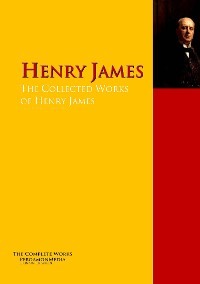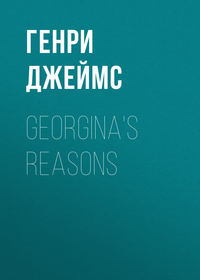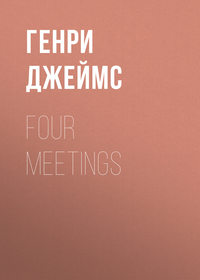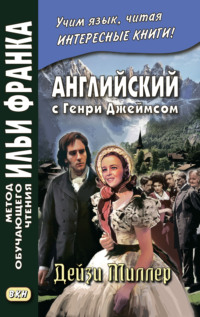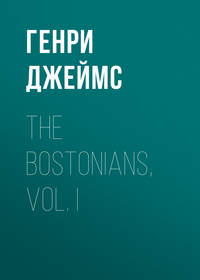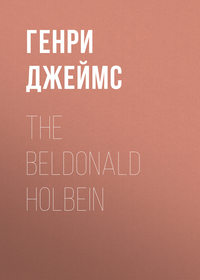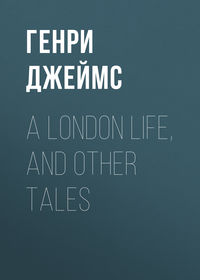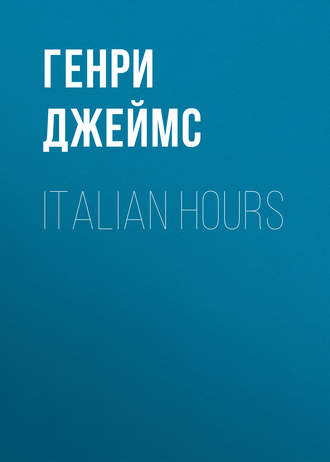 полная версия
полная версияItalian Hours
If St. John Lateran disappoints you internally, you have an easy compensation in pacing the long lane which connects it with Santa Maria Maggiore and entering the singularly perfect nave of that most delightful of churches. The first day of my stay in Rome under the old dispensation I spent in wandering at random through the city, with accident for my valet-de-place. It served me to perfection and introduced me to the best things; among others to an immediate happy relation with Santa Maria Maggiore. First impressions, memorable impressions, are generally irrecoverable; they often leave one the wiser, but they rarely return in the same form. I remember, of my coming uninformed and unprepared into the place of worship and of curiosity that I have named, only that I sat for half an hour on the edge of the base of one of the marble columns of the beautiful nave and enjoyed a perfect revel of—what shall I call it?—taste, intelligence, fancy, perceptive emotion? The place proved so endlessly suggestive that perception became a throbbing confusion of images, and I departed with a sense of knowing a good deal that is not set down in Murray. I have seated myself more than once again at the base of the same column; but you live your life only once, the parts as well as the whole. The obvious charm of the church is the elegant grandeur of the nave—its perfect shapeliness and its rich simplicity, its long double row of white marble columns and its high flat roof, embossed with intricate gildings and mouldings. It opens into a choir of an extraordinary splendour of effect, which I recommend you to look out for of a fine afternoon. At such a time the glowing western light, entering the high windows of the tribune, kindles the scattered masses of colour into sombre bright-ness, scintillates on the great solemn mosaic of the vault, touches the porphyry columns of the superb baldachino with ruby lights, and buries its shining shafts in the deep-toned shadows that hang about frescoes and sculptures and mouldings. The deeper charm even than in such things, however, is the social or historic note or tone or atmosphere of the church—I fumble, you see, for my right expression; the sense it gives you, in common with most of the Roman churches, and more than any of them, of having been prayed in for several centuries by an endlessly curious and complex society. It takes no great attention to let it come to you that the authority of Italian Catholicism has lapsed not a little in these days; not less also perhaps than to feel that, as they stand, these deserted temples were the fruit of a society leavened through and through by ecclesiastical manners, and that they formed for ages the constant background of the human drama. They are, as one may say, the churchiest churches in Europe—the fullest of gathered memories, of the experience of their office. There’s not a figure one has read of in old-world annals that isn’t to be imagined on proper occasion kneeling before the lamp-decked Confession beneath the altar of Santa Maria Maggiore. One sees after all, however, even among the most palpable realities, very much what the play of one’s imagination projects there; and I present my remarks simply as a reminder that one’s constant excursions into these places are not the least interesting episodes of one’s walks in Rome.
I had meant to give a simple illustration of the church-habit, so to speak, but I have given it at such a length as leaves scant space to touch on the innumerable topics brushed by the pen that begins to take Roman notes. It is by the aimless flânerie which leaves you free to follow capriciously every hint of entertainment that you get to know Rome. The greater part of the life about you goes on in the streets; and for an observer fresh from a country in which town scenery is at the least monotonous incident and character and picture seem to abound. I become conscious with compunction, let me hasten to add, that I have launched myself thus on the subject of Roman churches and Roman walks without so much as a preliminary allusion to St. Peter’s. One is apt to proceed thither on rainy days with intentions of exercise—to put the case only at that—and to carry these out body and mind. Taken as a walk not less than as a church, St. Peter’s of course reigns alone. Even for the profane “constitutional” it serves where the Boulevards, where Piccadilly and Broadway, fall short, and if it didn’t offer to our use the grandest area in the world it would still offer the most diverting. Few great works of art last longer to the curiosity, to the perpetually transcended attention. You think you have taken the whole thing in, but it expands, it rises sublime again, and leaves your measure itself poor. You never let the ponderous leather curtain bang down behind you—your weak lift of a scant edge of whose padded vastness resembles the liberty taken in folding back the parchment corner of some mighty folio page—without feeling all former visits to have been but missed attempts at apprehension and the actual to achieve your first real possession. The conventional question is ever as to whether one hasn’t been “disappointed in the size,” but a few honest folk here and there, I hope, will never cease to say no. The place struck me from the first as the hugest thing conceivable—a real exaltation of one’s idea of space; so that one’s entrance, even from the great empty square which either glares beneath the deep blue sky or makes of the cool far-cast shadow of the immense front something that resembles a big slate-coloured country on a map, seems not so much a going in somewhere as a going out. The mere man of pleasure in quest of new sensations might well not know where to better his encounter there of the sublime shock that brings him, within the threshold, to an immediate gasping pause. There are days when the vast nave looks mysteriously vaster than on others and the gorgeous baldachino a longer journey beyond the far-spreading tessellated plain of the pavement, and when the light has yet a quality which lets things loom their largest, while the scattered figures—I mean the human, for there are plenty of others—mark happily the scale of items and parts. Then you have only to stroll and stroll and gaze and gaze; to watch the glorious altar-canopy lift its bronze architecture, its colossal embroidered contortions, like a temple within a temple, and feel yourself, at the bottom of the abysmal shaft of the dome, dwindle to a crawling dot.
Much of the constituted beauty resides in the fact that it is all general beauty, that you are appealed to by no specific details, or that these at least, practically never importunate, are as taken for granted as the lieutenants and captains are taken for granted in a great standing army—among whom indeed individual aspects may figure here the rather shifting range of decorative dignity in which details, when observed, often prove poor (though never not massive and substantially precious) and sometimes prove ridiculous. The sculptures, with the sole exception of Michael Angelo’s ineffable “Pieta,” which lurks obscurely in a side-chapel—this indeed to my sense the rarest artistic combination of the greatest things the hand of man has produced—are either bad or indifferent; and the universal incrustation of marble, though sumptuous enough, has a less brilliant effect than much later work of the same sort, that for instance of St. Paul’s without the Walls. The supreme beauty is the splendidly sustained simplicity of the whole. The thing represents a prodigious imagination extraordinarily strained, yet strained, at its happiest pitch, without breaking. Its happiest pitch I say, because this is the only creation of its strenuous author in presence of which you are in presence of serenity. You may invoke the idea of ease at St. Peter’s without a sense of sacrilege—which you can hardly do, if you are at all spiritually nervous, in Westminster Abbey or Notre Dame. The vast enclosed clearness has much to do with the idea. There are no shadows to speak of, no marked effects of shade; only effects of light innumerably—points at which this element seems to mass itself in airy density and scatter itself in enchanting gradations and cadences. It performs the office of gloom or of mystery in Gothic churches; hangs like a rolling mist along the gilded vault of the nave, melts into bright interfusion the mosaic scintillations of the dome, clings and clusters and lingers, animates the whole huge and otherwise empty shell. A good Catholic, I suppose, is the same Catholic anywhere, before the grandest as well as the humblest altars; but to a visitor not formally enrolled St. Peter’s speaks less of aspiration than of full and convenient assurance. The soul infinitely expands there, if one will, but all on its quite human level. It marvels at the reach of our dreams and the immensity of our resources. To be so impressed and put in our place, we say, is to be sufficiently “saved”; we can’t be more than the heaven itself; and what specifically celestial beauty such a show or such a substitute may lack it makes up for in certainty and tangibility. And yet if one’s hours on the scene are not actually spent in praying, the spirit seeks it again as for the finer comfort, for the blessing, exactly, of its example, its protection and its exclusion. When you are weary of the swarming democracy of your fellow-tourists, of the unremunerative aspects of human nature on Corso and Pincio, of the oppressively frequent combination of coronets on carriage panels and stupid faces in carriages, of addled brains and lacquered boots, of ruin and dirt and decay, of priests and beggars and takers of advantage, of the myriad tokens of a halting civilisation, the image of the great temple depresses the balance of your doubts, seems to rise above even the highest tide of vulgarity and make you still believe in the heroic will and the heroic act. It’s a relief, in other words, to feel that there’s nothing but a cab-fare between your pessimism and one of the greatest of human achievements.
This might serve as a Lenten peroration to these remarks of mine which have strayed so woefully from their jovial text, save that I ought fairly to confess that my last impression of the Carnival was altogether Carnivalesque.. The merry-making of Shrove Tuesday had life and felicity; the dead letter of tradition broke out into nature and grace. I pocketed my scepticism and spent a long afternoon on the Corso. Almost every one was a masker, but you had no need to conform; the pelting rain of confetti effectually disguised you. I can’t say I found it all very exhilarating; but here and there I noticed a brighter episode—a capering clown inflamed with contagious jollity, some finer humourist forming a circle every thirty yards to crow at his indefatigable sallies. One clever performer so especially pleased me that I should have been glad to catch a glimpse of the natural man. You imagined for him that he was taking a prodigious intellectual holiday and that his gaiety was in inverse ratio to his daily mood. Dressed as a needy scholar, in an ancient evening-coat and with a rusty black hat and gloves fantastically patched, he carried a little volume carefully under his arm. His humours were in excellent taste, his whole manner the perfection of genteel comedy. The crowd seemed to relish him vastly, and he at once commanded a glee-fully attentive audience. Many of his sallies I lost; those I caught were excellent. His trick was often to begin by taking some one urbanely and caressingly by the chin and complimenting him on the intelligenza della sua fisionomia. I kept near him as long as I could; for he struck me as a real ironic artist, cherishing a disinterested, and yet at the same time a motived and a moral, passion for the grotesque. I should have liked, however—if indeed I shouldn’t have feared—to see him the next morning, or when he unmasked that night over his hard-earned supper in a smoky trattoria. As the evening went on the crowd thickened and became a motley press of shouting, pushing, scrambling, everything but squabbling, revellers. The rain of missiles ceased at dusk, but the universal deposit of chalk and flour was trampled into a cloud made lurid by flaring pyramids of the gas-lamps that replaced for the occasion the stingy Roman luminaries. Early in the evening came off the classic exhibition of the moccoletti, which I but half saw, like a languid reporter resigned beforehand to be cashiered for want of enterprise. From the mouth of a side-street, over a thousand heads, I caught a huge slow-moving illuminated car, from which blue-lights and rockets and Roman candles were in course of discharge, meeting all in a dim fuliginous glare far above the house-tops. It was like a glimpse of some public orgy in ancient Babylon. In the small hours of the morning, walking homeward from a private entertainment, I found Ash Wednesday still kept at bay. The Corso, flaring with light, smelt like a circus. Every one was taking friendly liberties with every one else and using up the dregs of his festive energy in convulsive hootings and gymnastics. Here and there certain indefatigable spirits, clad all in red after the manner of devils and leaping furiously about with torches, were supposed to affright you. But they shared the universal geniality and bequeathed me no midnight fears as a pretext for keeping Lent, the carnevale dei preti, as I read in that profanely radical sheet the Capitale. Of this too I have been having glimpses. Going lately into Santa Francesca Romana, the picturesque church near the Temple of Peace, I found a feast for the eyes—a dim crimson-toned light through curtained windows, a great festoon of tapers round the altar, a bulging girdle of lamps before the sunken shrine beneath, and a dozen white-robed Dominicans scattered in the happiest composition on the pavement. It was better than the moccoletti.
1873ROMAN RIDES
I shall always remember the first I took: out of the Porta del Popolo, to where the Ponte Molle, whose single arch sustains a weight of historic tradition, compels the sallow Tiber to flow between its four great-mannered ecclesiastical statues, over the crest of the hill and along the old posting-road to Florence. It was mild midwinter, the season peculiarly of colour on the Roman Campagna; and the light was full of that mellow purple glow, that tempered intensity, which haunts the after-visions of those who have known Rome like the memory of some supremely irresponsible pleasure. An hour away I pulled up and at the edge of a meadow gazed away for some time into remoter distances. Then and there, it seemed to me, I measured the deep delight of knowing the Campagna. But I saw more things in it than I can easily tell. The country rolled away around me into slopes and dells of long-drawn grace, chequered with purple and blue and blooming brown. The lights and shadows were at play on the Sabine Mountains—an alternation of tones so exquisite as to be conveyed only by some fantastic comparison to sapphire and amber. In the foreground a contadino in his cloak and peaked hat jogged solitary on his ass; and here and there in the distance, among blue undulations, some white village, some grey tower, helped deliciously to make the picture the typical “Italian landscape” of old-fashioned art. It was so bright and yet so sad, so still and yet so charged, to the supersensuous ear, with the murmur of an extinguished life, that you could only say it was intensely and adorably strange, could only impute to the whole overarched scene an unsurpassed secret for bringing tears of appreciation to no matter how ignorant—archaeologically ignorant—eyes. To ride once, in these conditions, is of course to ride again and to allot to the Campagna a generous share of the time one spends in Rome.
It is a pleasure that doubles one’s horizon, and one can scarcely say whether it enlarges or limits one’s impression of the city proper. It certainly makes St. Peter’s seem a trifle smaller and blunts the edge of one’s curiosity in the Forum. It must be the effect of the experience, at all extended, that when you think of Rome afterwards you will think still respectfully and regretfully enough of the Vatican and the Pincio, the streets and the picture-making street life; but will even more wonder, with an irrepressible contraction of the heart, when again you shall feel yourself bounding over the flower-smothered turf, or pass from one framed picture to another beside the open arches of the crumbling aqueducts. You look back at the City so often from some grassy hill-top—hugely compact within its walls, with St. Peter’s overtopping all things and yet seeming small, and the vast girdle of marsh and meadow receding on all sides to the mountains and the sea—that you come to remember it at last as hardly more than a respectable parenthesis in a great sweep of generalisation. Within the walls, on the other hand, you think of your intended ride as the most romantic of all your possibilities; of the Campagna generally as an illimitable experience. One’s rides certainly give Rome an inordinate scope for the reflective—by which I suppose I mean after all the aesthetic and the “esoteric”—life. To dwell in a city which, much as you grumble at it, is after all very fairly a modern city; with crowds and shops and theatres and cafes and balls and receptions and dinner-parties, and all the modern confusion of social pleasures and pains; to have at your door the good and evil of it all; and yet to be able in half an hour to gallop away and leave it a hundred miles, a hundred years, behind, and to look at the tufted broom glowing on a lonely tower-top in the still blue air, and the pale pink asphodels trembling none the less for the stillness, and the shaggy-legged shepherds leaning on their sticks in motionless brotherhood with the heaps of ruin, and the scrambling goats and staggering little kids treading out wild desert smells from the top of hollow-sounding mounds; and then to come back through one of the great gates and a couple of hours later find yourself in the “world,” dressed, introduced, entertained, inquiring, talking about “Middlemarch” to a young English lady or listening to Neapolitan songs from a gentleman in a very low-cut shirt—all this is to lead in a manner a double life and to gather from the hurrying hours more impressions than a mind of modest capacity quite knows how to dispose of.
I touched lately upon this theme with a friend who, I fancied, would understand me, and who immediately assured me that he had just spent a day that this mingled diversity of sensation made to the days one spends elsewhere what an uncommonly good novel may be to the daily paper. “There was an air of idleness about it, if you will,” he said, “and it was certainly pleasant enough to have been wrong. Perhaps, being after all unused to long stretches of dissipation, this was why I had a half-feeling that I was reading an odd chapter in the history of a person very much more of a héros de roman than myself.” Then he proceeded to relate how he had taken a long ride with a lady whom he extremely admired. “We turned off from the Tor di Quinto Road to that castellated farm-house you know of—once a Ghibelline fortress—whither Claude Lorraine used to come to paint pictures of which the surrounding landscape is still so artistically, so compositionally, suggestive. We went into the inner court, a cloister almost, with the carven capitals of its loggia columns, and looked at a handsome child swinging shyly against the half-opened door of a room whose impenetrable shadow, behind her, made her, as it were, a sketch in bituminous water-colours. We talked with the farmer, a handsome, pale, fever-tainted fellow with a well-to-do air that didn’t in the least deter his affability from a turn compatible with the acceptance of small coin; and then we galloped away and away over the meadows which stretch with hardly a break to Veii. The day was strangely delicious, with a cool grey sky and just a touch of moisture in the air stirred by our rapid motion. The Campagna, in the colourless even light, was more solemn and romantic than ever; and a ragged shepherd, driving a meagre straggling flock, whom we stopped to ask our way of, was a perfect type of pastoral, weather-beaten misery. He was precisely the shepherd for the foreground of a scratchy etching. There were faint odours of spring in the air, and the grass here and there was streaked with great patches of daisies; but it was spring with a foreknowledge of autumn, a day to be enjoyed with a substrain of sadness, the foreboding of regret, a day somehow to make one feel as if one had seen and felt a great deal—quite, as I say, like a heros de roman. Touching such characters, it was the illustrious Pelham, I think, who, on being asked if he rode, replied that he left those violent exercises to the ladies. But under such a sky, in such an air, over acres of daisied turf, a long, long gallop is certainly a supersubtle joy. The elastic bound of your horse is the poetry of motion; and if you are so happy as to add to it not the prose of companionship riding comes almost to affect you as a spiritual exercise. My gallop, at any rate,” said my friend, “threw me into a mood which gave an extraordinary zest to the rest of the day.” He was to go to a dinner-party at a villa on the edge of Rome, and Madam X—, who was also going, called for him in her carriage. “It was a long drive,” he went on, “through the Forum, past the Colosseum. She told me a long story about a most interesting person. Toward the end my eyes caught through the carriage window a slab of rugged sculptures. We were passing under the Arch of Constantine. In the hall pavement of the villa is a rare antique mosaic—one of the largest and most perfect; the ladies on their way to the drawing-room trail over it the flounces of Worth. We drove home late, and there’s my day.”
On your exit from most of the gates of Rome you have generally half-an-hour’s progress through winding lanes, many of which are hardly less charming than the open meadows. On foot the walls and high hedges would vex you and spoil your walk; but in the saddle you generally overtop them, to an endless peopling of the minor vision. Yet a Roman wall in the springtime is for that matter almost as interesting as anything it conceals. Crumbling grain by grain, coloured and mottled to a hundred tones by sun and storm, with its rugged structure of brick extruding through its coarse complexion of peeling stucco, its creeping lacework of wandering ivy starred with miniature violets, and its wild fringe of stouter flowers against the sky—it is as little as possible a blank partition; it is practically a luxury of landscape. At the moment at which I write, in mid-April, all the ledges and cornices are wreathed with flaming poppies, nodding there as if they knew so well what faded greys and yellows are an offset to their scarlet. But the best point in a dilapidated enclosing surface of vineyard or villa is of course the gateway, lifting its great arch of cheap rococo scroll-work, its balls and shields and mossy dish-covers—as they always perversely figure to me—and flanked with its dusky cypresses. I never pass one without taking out my mental sketch-book and jotting it down as a vignette in the insubstantial record of my ride. They are as sad and dreary as if they led to the moated grange where Mariana waited in desperation for something to happen; and it’s easy to take the usual inscription over the porch as a recommendation to those who enter to renounce all hope of anything but a glass of more or less agreeably acrid vino romano. For what you chiefly see over the walls and at the end of the straight short avenue of rusty cypresses are the appurtenances of a vigna—a couple of acres of little upright sticks blackening in the sun, and a vast sallow-faced, scantily windowed mansion, whose expression denotes little of the life of the mind beyond what goes to the driving of a hard bargain over the tasted hogsheads. If Mariana is there she certainly has no pile of old magazines to beguile her leisure. The life of the mind, if the term be in any application here not ridiculous, appears to any asker of curious questions, as he wanders about Rome, the very thinnest deposit of the past. Within the rococo gateway, which itself has a vaguely esthetic self-consciousness, at the end of the cypress walk, you will probably see a mythological group in rusty marble—a Cupid and Psyche, a Venus and Paris, an Apollo and Daphne—the relic of an age when a Roman proprietor thought it fine to patronise the arts. But I imagine you are safe in supposing it to constitute the only allusion savouring of culture that has been made on the premises for three or four generations.


